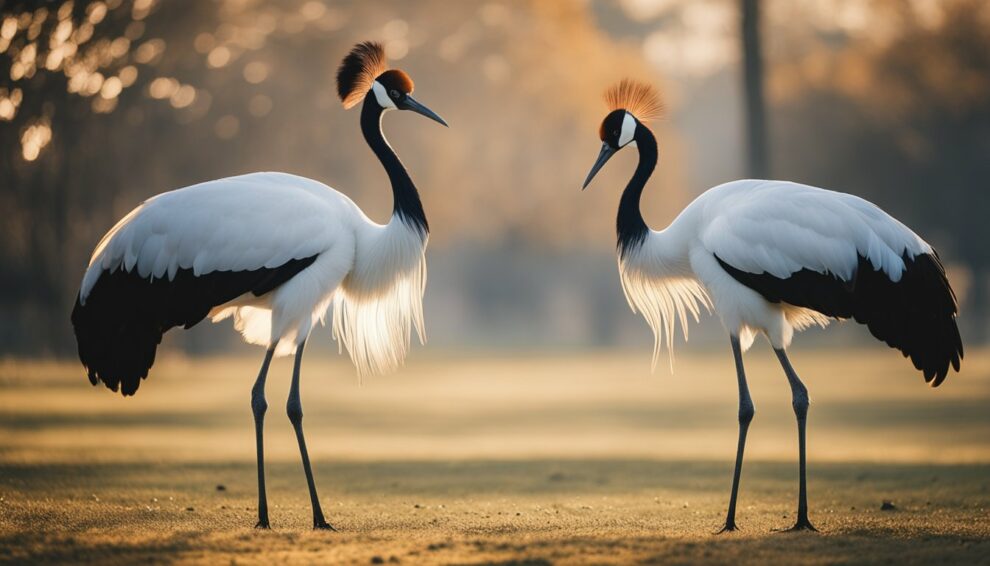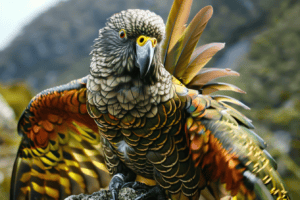Imagine stepping into the serene wetlands of East Asia and catching sight of a dance as old as time itself.
The red-crowned crane, with its striking patch of red atop its head, takes center stage in a performance that captures the essence of elegance.
Known in Japan as the Tancho, these cranes embody qualities that humans hold dear: fidelity, luck, and love.
Considered a symbol of peace, they can transform their habitat into a tableau of tranquility that resonates deeply with onlookers.

Among snowy plains or marshes, pairs of red-crowned cranes can be seen partaking in their courtship ritual, a dance composed of intricate steps, deep bows, and synchronized leaps.
This dance isn’t just for show, it helps to strengthen the bonds between mates, and interestingly, these cranes usually pair for life.
It’s no wonder that this captivating bird has soared into the hearts of many as a cultural icon, featuring prominently in Japanese folklore and art.
Could you imagine a connection so strong, reflected in a dance that’s been perfected over millennia?
The Red-Crowned Crane and Its Habitat
The majestic Red-Crowned Crane graces various landscapes across Asia with its presence, engaging in intricate mating displays during breeding season.
Let’s explore the diversity of their habitats and the unique behaviors these cranes exhibit.
Habitat Spanning Continents
These cranes inhabit a broad range of areas from the eastern reaches of Russia, through China and down to Korea.
They migrate across these regions, seeking the tranquil marshes and wetlands as their preferred homes.
In the winter, they can be commonly spotted in the Korean Demilitarized Zone, thriving in this human-free sanctuary.
A Bird of Many Names
Known in Japan as the ‘Tancho’, the Red-Crowned Crane is celebrated as a national symbol, embodying peace and longevity.
While it’s commonly called the Japanese Crane, its scientific recognition goes beyond these borders, highlighting its existence across multiple Asian countries.
Courtship in the Cranes’ Life
The Red-Crowned Crane’s courtship dance is a spectacle of nature, eloquent and emotional.
During the breeding season, cranes can be observed presenting a captivating performance of synchronized movements – jumping high, bowing, and twirling in an elegant choreography that solidifies their lifelong bonds.
Observing The Cranes in Tsurui
Tsurui, a village on the island of Hokkaido in northern Japan, offers a picturesque setting for observing these cranes.
During the frigid winters, layers of snow and ice-fog set the scene for the Red-Crowned Cranes as they engage in their courtship rituals, creating a magical experience for any bird enthusiast.
Cultural Significance and Symbolism
The Red-Crowned Crane is not just a bird but an integral part of Asian culture.
Often found in the art of origami, these birds symbolize good fortune and fidelity.
Their red crown is seen as a sign of nobility, inspiring awe and reverence in the hearts of those who observe them.
Conservation Efforts for Future Generations
Despite the reverence they hold, Red-Crowned Cranes are endangered, largely due to habitat loss and hunting pressures.
Local governments and conservation organizations are actively working to protect these cranes, emphasizing the importance of preserving eggs and habitats to ensure future generations also have the opportunity to witness the crane’s captivating dance.
By educating onlookers and providing safe environments, they highlight the essence of ecological guardianship.
Conservation measures include creating feeding grounds and imposing hunting restrictions to diminish threats to the cranes, with the hope that these magnificent birds will flourish for years to come.
Attuning to the Crane’s Lifestyle

Discovering the red-crowned crane’s lifestyle requires an understanding of their behaviors throughout the seasons, what they eat, where they nest, how they interact, and their overall life expectancy.
Seasonal Behaviors of Cranes
Red-crowned cranes are native to East Asia, displaying seasonal adaptability that is key to their survival.
During the frigid winters, they engage in a striking display of courtship dances on ice-covered grounds, seemingly unfazed by the cold and ice-fog common to their wintry habitat.
With the arrival of spring, the focus shifts to breeding, and these birds are often seen in pairs, reinforcing their bonds through elaborate dances and synchronized calls.
Feeding Grounds and Diet
While cranes are generally omnivorous, the red-crowned crane has a varied diet that changes with the availability of food across different seasons.
In their preferred marshes and wetlands, they can be spotted gracefully foraging with their long legs, subsisting on a mix of plants and grains in summer.
Winter drives them to more open feeding grounds where they must subsist on whatever sustenance the sparse landscape provides, such as small fish or amphibians.
Nesting and Breeding Habits
These cranes are meticulous when it comes to choosing a site for their nest.
Often secluded and within the marshlands, their nests are crafted from plants and mud, creating a safe haven for breeding.
The breeding season is a tender time, where pairs incubate their eggs and later protect their precious chicks, teaching them to navigate the complexities of their world.
Social Structure and Interaction
The red-crowned crane isn’t just an emblem of solitude and grace; they exhibit a highly social structure.
In the non-breeding season, they can be found roosting in large groups, which provides safety and warmth.
Their courtship dances extend beyond just a pair’s ritual; they are also a part of the crane community’s fabric, strengthening the ties within their flocks.
Life Expectancy and Survival
With a wingspan that can reach up to 2.5 meters, these cranes’ majestic presence is complemented by their impressive longevity.
In the wild, they are marveled at for their lifespan, which can extend to 30 years or more, coming close to the mythic longevity of 1,000 years celebrated in Japanese tradition.
Their survival, however, hinges on the continued preservation of their habitats and the balance of their delicate ecosystem.
The Graceful Dance of Courtship

The Red-crowned Crane performs a captivating ritual to woo its mate, involving intricate dances and a series of calls.
This performance is not just a display of beauty but a vital part of their mating process.
Elements of the Courtship Ritual
During the all-important courtship, Red-crowned Cranes exhibit a variety of behaviors that show off their physical prowess and compatibility.
One can witness these cranes bowing ceremoniously, leaping high into the air, and engaging in a synchronized dance that is both elegant and purposeful.
The dance involves flapping their wings vigorously, stretching their long necks, and leaping gracefully.
The Red-crowned Cranes boast a wingspan that can measure up to 2.5 meters, which adds to the grandeur of their performance.
Their ritual is a careful step-by-step process, as if every movement were rehearsed to perfection.
The dance often includes throwing objects like sticks or grass into the air, an exciting spectacle for anyone lucky enough to observe.
In the wintery canvas of Hokkaido, this mating dance becomes a breathtaking scene, standing out against the snowy plains.
Understanding Courtship Displays
The function of these courtship displays extends beyond mere aesthetics. Through this ritual, the cranes establish and strengthen their bonds.
The calls that accompany the dance serve as a duet between partners, further solidifying their connection.
The variety of calls includes a contact call to indicate their location to each other amidst the vast landscapes they inhabit.
Experiencing the courtship display is like watching a natural ballet, where each movement is full of intent and grace.
Should you seek to capture the essence of their dance, video recordings are available on platforms like YouTube, showcasing these alluring moments.
These videos not only entertain but also educate viewers through visual storytelling of the cranes’ mating practices.
For a bird species that mates for life, the courtship dance is a critical communication tool, ensuring partners are in sync with one another.
Observing the Red-crowned Cranes’ courtship is a lesson in loyalty and connection in the animal kingdom, a heartwarming insight suitable for young and old alike.
Have you ever wondered what it would feel like to communicate so deeply without words, just like these cranes?
Connecting with Red-Crowned Cranes

Exploring the natural habitats of the red-crowned cranes offers a unique opportunity to connect with these majestic birds, engage in cultural activities, and contribute to their conservation.
Eco-Tourism and Bird Watching in Hokkaido
Nestled in the eastern parts of Hokkaido, Japan, areas such as Kushiro and the Tsurui village serve as prime eco-tourism destinations.
Here, visitors from around the world can observe groups of red-crowned cranes gracefully dancing across snow-covered plains.
Bird watching, especially from dedicated guesthouses like Shiretoko Serai, often incorporates the use of tripods for steady viewing.
Organized tours led by companies such as Saiyu Travel offer a structured experience while emphasizing respect for the wildlife of Japan.
Crane-Inspired Pleasantries and Crafts
Local craftsmen in Hokkaido celebrate the beauty of the red-crowned cranes through intricate creations.
Imagine folding a piece of paper into the traditional origami crane; this activity, echoing Japan’s cultural heritage, symbolizes good fortune and long life.
The crane motif extends to regional delights as unique as crane-shaped pasta and ice cream treats, which both locals and tourists find delightful.
Conservation Heroes and Stories
The preservation efforts in places like the Ito Sanctuary reveal inspiring stories of conservation.
Local governments and non-profit organizations work tirelessly to maintain the cranes’ habitats.
These conservation heroes provide educational programs to visitors, instilling the importance of safeguarding the wildlife for future generations.
Understanding their monumental efforts can spark a deeper appreciation for the local governments’ roles in wildlife conservation.
The Lure of Crane Watching
Rausu, a small town on the Shiretoko Peninsula, offers bird watching enthusiasts a scenic backdrop against which they can watch the red-crowned cranes.
Visitors equipped with cameras and binoculars gather in sanctuaries and specific lookouts to observe these creatures amidst nature.
The serenity and charm of observing the cranes in their natural habitat not only captivate wildlife enthusiasts but also play a significant role in the eco-tourism industry of Japan.
Frequently Asked Questions

In this section, we’ll uncover the mystical dances of the red-crowned crane and explore how these beautiful birds showcase their affection, reflect cultural reverence, and nurture their young.
Why do red-crowned cranes perform dances during their courtship rituals?
Red-crowned cranes have a captivating dance that functions as a means of communication and pair bonding.
During the courtship, they engage in an elaborate dance that includes bowing, jumping, wing flapping, and vocalizations to strengthen their bonds and express readiness to mate.
How does the courtship display of the red-crowned crane differ from other bird species?
Their courtship dance is distinct with its synchronized and graceful movements.
Unlike many bird species where only the male displays, both male and female red-crowned cranes participate in the dance, reflecting their lifelong monogamous partnerships.
What significance do red-crowned cranes hold in East Asian cultures?
These cranes are not just birds but symbols deeply rooted in East Asian culture, representing longevity and fidelity.
They feature prominently in art and folklore and are cherished as harbingers of joy and eternal love in places like Japan and China.
Can you describe the typical behaviors observed in a red-crowned crane’s courtship?
During courtship, red-crowned cranes engage in a sequence of choreographed steps: they toss grass in the air, pirouette in unison, and let out unison calls that resonate across their habitat.
These rituals showcase their compatibility to potential mates and reinforce their existing pair bonds.
What are the environmental needs for red-crowned cranes to perform their mating rituals?
Red-crowned cranes need undisturbed wetlands to carry out their courtship dances successfully.
They require a safe and serene setting, with enough space to exhibit their complex moves and ample nesting materials—qualities critical for their reproduction.
How do red-crowned cranes take care of their young after the courtship process?
Once eggs are laid, both the male and female cranes share incubation duties.
After hatching, the parents are attentive, teaching their chicks how to forage and protect themselves from predators, ensuring the survival of the next crane generation.









